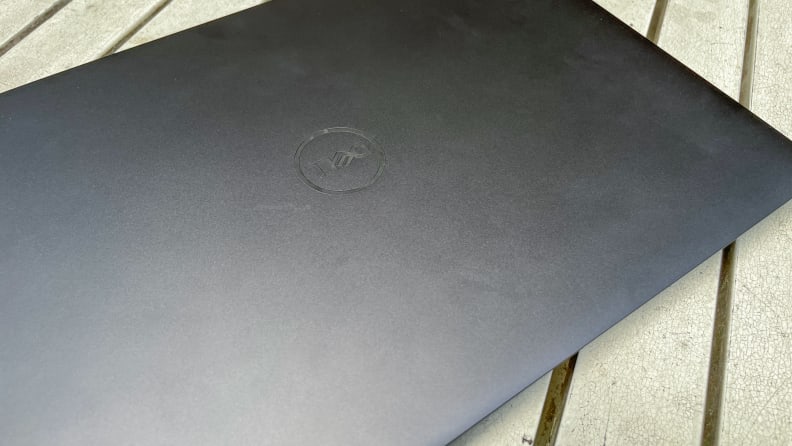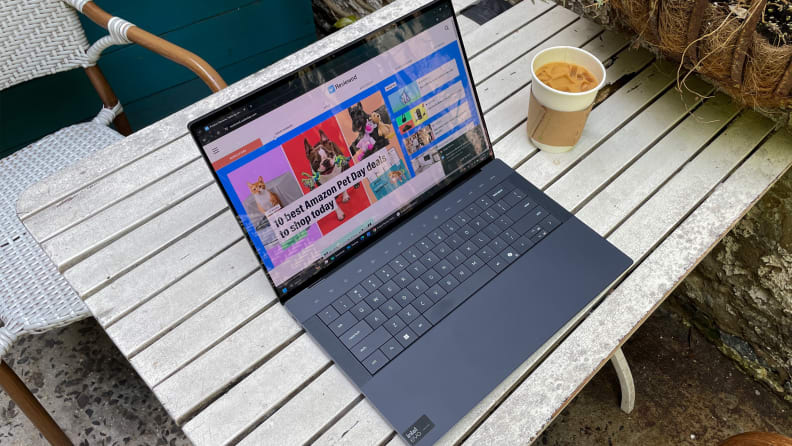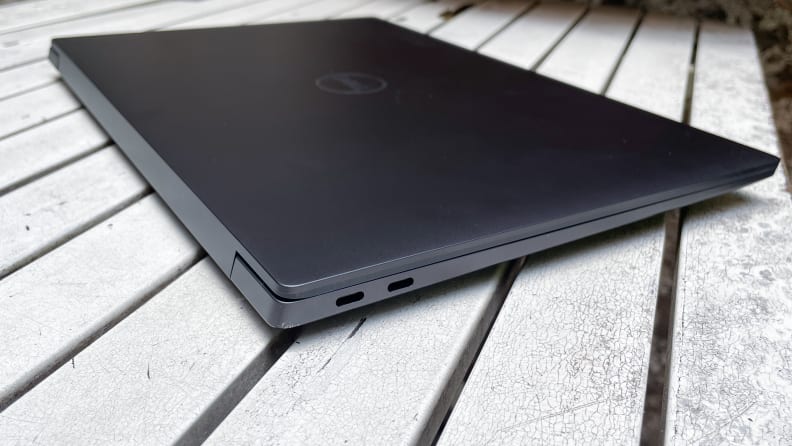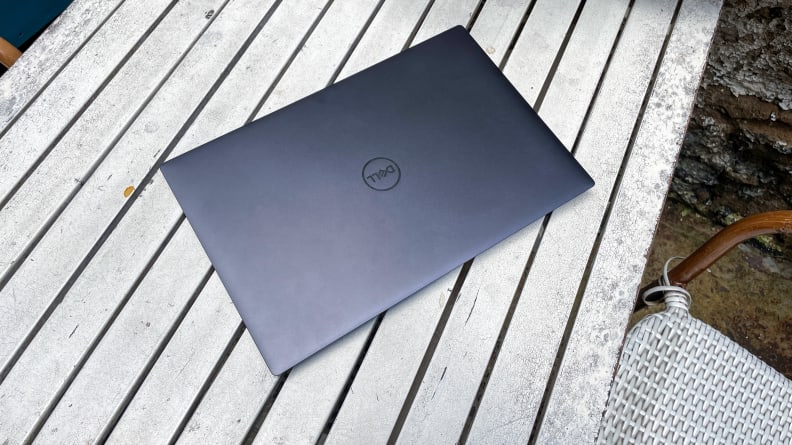Pros
-
Sleek and well-built
-
Redesigned keyboard is surprisingly good
-
Runs cool and quiet
Cons
-
Finish attracts fingerprints like a magnet
-
Upgrades are expensive
-
Touch bar is unnecessary
About the Dell XPS 14 (2024)
The 2024 Dell XPS 14 is a new entry into the XPS line; a 14.5-inch productivity laptop that, like the Dell XPS 16, uses a reconfigured lattice-free keyboard, meaning it lacks spaces between each key.
It’s now a signature feature of the XPS lineup, along with a rigid unibody aluminum chassis, Piezo haptic touchpad integrated into the palm rest and finished with a soft-touch texture, and redesigned screen bezels and shrunken-down webcam.
The XPS 14 starts at $1,699 for the most basic configuration, which includes 16GB of LPDDR5x RAM at 6400 MHz, 512GB of storage, and a 14.5-inch, 1920 x 1200, 60Hz IPS display. All models come equipped with an Intel Core Ultra 7 155H processor and integrated Arc graphics.
The model we reviewed has 32GB of LPDDR5x RAM clocked at 7467 MHz, 1TB of storage, the optional OLED screen that tops out at 120Hz, and a discrete mobile Nvidia RTX 4050 graphics card, although it’s locked to a maximum of only 30 watts. For $400 more, buyers can reach a total of 64GB of RAM, and storage options up to 4TB are available. Dell offers the XPS 14 and 16 in either platinum or graphite colorways; we reviewed the latter.
Dell XPS 14 (2024) specs

The Dell XPS 14 base configuration starts at $1,699 and includes 16GB of RAM, 512 GB of storage, and an IPS display.
- Price as configured: $2,699
- Processor: Intel Core Ultra 7 155H, 16 cores, 22 threads, boost clock up to 4.8GHz
- Graphics: Nvidia RTX 4050 6GB mobile (discrete, 30-watt maximum), Intel Arc integrated graphics
- RAM: 32GB LPDDR5x at 7467 MHz (soldered)
- Storage: 1TB M.2 NVMe PCIe 4.0 solid state drive
- Display: 14.5-inch 3200 x 2000 OLED 120Hz, capacitive touchscreen
- Wireless connectivity: Wi-Fi 6E, Bluetooth 5.4
- Ports: 3 x Thunderbolt 4 (USB-C) with power delivery and DisplayPort out, 1 x microSDXC card reader (v6.0), 1 x 3.5mm headphone/microphone combo jack
- Battery: 6-Cell, 69.5Whr
- Camera: 1080p at 30 fps FHD RGB-IR camera, Windows Hello compatible
- Weight: 3.9 pounds (1.77 kilograms)
- Dimensions: 12.6 x 8.5 x .71 inches
- Special features: Borderless Piezo haptic touchpad with Gorilla Glass surface, integrated fingerprint reader, included USB-C to USB-A and HDMI adapter, VESA DisplayHDR 500-rated display
- Warranty: 1-year hardware and software support with onsite diagnosis
What we like

Gorilla Glass covers above and below the keyboard, including the excellent touchpad, and contributes to the laptop's sturdy feel.
It’s rock solid and well designed
Dell has always gone above and beyond when it comes to build quality on the XPS line, and the XPS 14 is no exception. The chassis is aluminum, and Gorilla Glass covers above and below the keyboard for the palm rest, touchpad area, and the touch bar below the screen. This means there is absolutely zero flex anywhere on the laptop, including when trying to wiggle the screen, although all of this glass does make the XPS 14 heavier than competitors at nearly 4 pounds.
The new trackpad, which uses Piezo motors to emulate the feel of a click instead of physical buttons, is fantastic. It’s large (six inches across), easily lets fingers glide across it, and possesses seemingly perfect palm rejection. The bezels around the screen are ultra slim, meaning Dell has been able to fit a 14.5-inch screen into the body of a 13-inch laptop.
Thankfully this doesn’t mean a reduction in webcam quality. The test footage I captured looks good for a laptop webcam and maintains proper exposure on my face even with a sunny window and lamp directly behind me. Colors also seem accurate enough, although I did catch a bit of chromatic aberration (colorful fringing) around the edges of certain objects like my hair. The onboard microphones are serviceable; I wouldn’t be embarrassed to hop on a work Zoom call from this laptop.
The fit and finish of every component is so tight that I nearly broke my spudger tools trying to pry the bottom cover off (after removing eight T5 torque screws). Once inside, every other component is similarly screwed in with T5 torque screws, so replacing a dead fan should be easy, if it comes down to it. Unfortunately, while the storage is upgradeable, the RAM and Wi-Fi card are soldered down.
Even the new color options scream elegance. The graphite colorway has a richness and depth to it, as well as a hint of reflectiveness, that’s sorely lacking from the plain aluminum finish of the M3 Apple MacBook Pro. It’s a fingerprint magnet, though. The backside of our test unit quickly became cloudy with fingerprints and wiping it down with a microfiber cloth failed to remove them.
The new keyboard is pretty dang good
As a former Dell XPS 13 non-Plus owner, I was initially skeptical of the redesigned keyboard that crams all of the keys together into a monolithic block without gaps. That all melted away once I actually started typing on the XPS 14.
The layout is instantly familiar and I was able to hit an average of 92 words per minute and 97% accuracy on the Monkeytype typing test, on par with the 8Bitdo Retro Mechanical Keyboard I use every day. Each key has a satisfying tactile feeling when depressed and actuates (depresses) the same no matter where you press on the keycap. The keys are subtly curved (Dell claims a .3 mm indent), so much so that it’s nearly invisible to the naked eye but still guides your fingers toward the center of each keycap.
It’s cool and quiet
No matter how thoroughly we stress tested the XPS 14, one fact remained constant: This is a cool, quiet laptop that you’ll be able to use on your bare legs or in bed without fear of overheating. Dell has removed all air vents from the bottom of the device and shifted the bulk of cooling to the area under the touchbar. This ensures that the underside, keyboard, and palmrest remain cool to the touch.
The XPS 14 is also remarkably quiet under normal operation. Even when the Performance mode profile was engaged in the MyDell software, unlocking maximum performance, the noise was comparable to a desktop air cooler, or not very noticeable. The fans never ramped up unexpectedly, either.
While the XPS 14 does a great job of keeping its exterior cool, the insides can get toasty. During benchmarking, we noticed that the Intel Core Ultra 7 155H CPU often shot up to 105 degrees Celsius and thermal throttled, though this didn’t negatively impact our results too much. The XPS 14, at least on the processor side, scored near the top of our productivity laptop rankings across the board, only beat out by the various flavors of M1/M2/M3-powered MacBook Pros and the XPS 16.
In Cinebench R23, a benchmark that synthetically stresses the CPU to render an image, the XPS 14 scored 1721 on the single-core test and 12859 on the multicore test—both respectable figures. For comparison’s sake, the XPS 16, which uses the same Core 7 155H chip, scored 1703 and 17873 on the same tests, respectively, likely due to the beefier cooling solution.
The same held true in our Geekbench 6 single and multicore tests, where the XPS 14 scored 1671 and 12191, respectively, putting it in the top ten results for the latter. If you edit a lot of video, manage databases, or run data analysis and need good multicore performance, the XPS 14 won’t disappoint. It’s just not the fastest device you can buy right now.
Excellent screen and speakers

Even though the OLED screen doesn't quite hit its brightness claim, the display delivers stunning visuals.
Dell continues to go above and beyond with its laptops’ speakers and screens. Although we didn’t quite hit the brightness figures the 120Hz OLED panel on our review unit is rated for (we measured a maximum brightness of 384 nits in SDR versus the 400 nits the panel is rated for, and 413 nits with HDR enabled, falling short of the 500 nits promised), it has excellent contrast, color accuracy, and motion clarity. The 3200 x 2000 resolution means that the pixel density (260 pixels per inch), is high enough to hide individual pixels even when your face is pressed against the screen.
Movies and TV shows look excellent, and the near-instantaneous pixel response times (how quickly a pixel shifts from one color to another) means that games also feel snappy and responsive. This all should be expected, as plenty of competitors are using the same Samsung Display panel. Dell adds a touch digitizer to their OLED screen, but if you’re not someone who regularly uses touch input, it’s not that useful. On the contrary, the digitizer layer is visible from about 8 inches away and adds a slightly annoying moire effect over everything. It’s likely most people won’t ever notice this, however.
The XPS 14 boasts four speakers that pull a combined 8 watts and support for Dolby Atmos and 3D stereo sound. I’ll be blunt; these are likely the best-sounding speakers I’ve experienced on a Windows laptop, but Dell still can’t beat Apple when it comes to laptop audio quality.
I tested the XPS 14 side by side with my M2 MacBook Pro 14. The XPS 14 delivers especially good sound for its size, a nice, wide soundstage, and can get extremely loud without distortion at max volume. However, the differences are obvious even at reasonable volume levels. In Janelle Monáe’s The Age of Pleasure, the singer’s voice feels a bit flat and tinny on the XPS 14, while the ‘70s-influenced Afrobeats backing most tracks is anemic and sometimes hard to distinguish owing to a lack of bass.
The same held true for Mitski’s Laurel Hell, where the resonant twang of guitar in tracks like “Working for the Knife” fails to distinguish itself in the mix and the vocals feel compressed. None of these deficiencies are present on the MacBook, but that’s not to say the XPS puts out bad audio by any means. It’s just outclassed, but for most people it will sound more than good enough while gaming or watching a movie.
What we don’t like

Many of the optional upgrades don't justify the price increases.
Upgrades aren’t worth the price
The XPS 14 is an expensive laptop even at the bare minimum configuration ($1,699), and the numerous upgrades available don’t all justify their high prices.
Our test unit is near the top end of what Dell offers, but, like the 2024 XPS 16, doesn’t wow from a performance perspective. The biggest offender is the $450 option to add in a dedicated graphics card, the mobile Nvidia RTX 4050. On the surface this might seem like a nice perk; a laptop this expensive should be able to do everything, including game when the need arises. I know if I was spending over $2,000 on a laptop I wouldn’t want to have to buy a separate computer just for gaming.
While the XPS 14 isn’t pitched as a gaming laptop, the results we logged are still disappointing. The RTX 4050, already an anemic GPU, is limited to only 30 watts and turned in gaming performance that rivaled the entry-level 2024 Lenovo LOQ with an Intel Arc A530m graphics card. It isn’t worth the upcharge, although we have seen it as low as only $100 more on sale, which may be worth it.
Baldur’s Gate 3, although not in our test suite for gaming laptops, was straight-up unplayable. Even with the power profile set to performance mode, medium settings, and DLSS upscaling turned on and set to performance, the game pinged back and forth between 25 frames per second (fps) and 60, with dips into the single digits with the audio stuttering and slurring. Changing the resolution to 1920 x 1200 did nothing to ameliorate this, nor did waiting for shaders to cache.
The environments looked dark, moody, and appropriately colorful on the high-res OLED panel, but this is unplayable. We tested the game in the Underdark area of Act 1 around the Myconid colony and later acts are only more demanding.
Cyberpunk 2077 fared much better, scoring 36 fps at 1080p with ultra settings enabled, and 58 fps at the native 3200 x 2000 resolution when DLSS was set to performance mode. That doesn’t take advantage of the XPS 14’s 120Hz panel but is still playable and the game looks pretty good. Horizon Zero Dawn was a similar story, averaging 32 fps at ultra settings on 1080p and 57 fps at ultra settings when DLSS was enabled at the laptop’s native resolution.
If you want a great gaming experience, buy a gaming laptop. The 2024 Asus ROG Zephyrus G16 blows the XPS out of the water in every game we tested thanks to its Nvidia RTX 4060 GPU at only $1,600, and it even uses the same 120Hz OLED panel. If you want an all-in-one machine that can game sometimes, or are an architect or designer and need a dedicated GPU in your productivity laptop, the XPS 14 offers it but it will cost you.
To make matters worse, Dell locks faster RAM configurations behind the RTX 4050 option. Without it, your options are 16 or 32GB of 6400MHz DDR5 RAM, or 64GB of 7467MHz RAM for $1,000 more. Selecting the dedicated GPU allows for 7467MHz 16GB and 32GB RAM options. In practice, this would only be a small bump in performance, but considering Dell solders the RAM onto the motherboard in the name of maximizing speed and doesn’t allow you to upgrade it after purchasing, it’s disappointing.
The touch bar is gimmicky, even detrimental
Even as an ardent defender of the MacBook Pro touch bar (RIP), I can’t get behind how the Dell touch bar is implemented on the XPS 14 and 16. Rather than using that space for a row of secondary actions that change depending on the context, Dell has shunted the function keys, Esc, home, end, insert, and delete up to a digital touch bar below the screen. Going to hit the escape key by touch and occasionally missing just feels bad, and you can’t remap or change the key locations on the touchbar.
If you regularly write and edit on your laptop, getting rid of a dedicated delete key will likely hamper your workflow. Pressing the fn key brings up the function row, which is functional but feels weird in circumstances where you’d use it regularly, like refreshing a webpage or hitting the shortcuts for quick saving and loading in games like the Fallout series or Baldur’s Gate 3.
Other laptops like the 2024 Asus ROG Zephyrus G14 or Lenovo ThinkPad P14s Gen 4 keep a physical row of secondary and media control keys at the top of the keyboard without compromising on key size. The touch bar just feels gimmicky.
The seamless trackpad needs to be outlined
This is a minor nitpick as the touchpad on the XPS 14 is responsive, feels great to glide across, and has seemingly perfect palm rejection, but I wish Dell had marked its borders.
The trackpad is wider than you’d expect (about six inches across) and seamlessly integrates into the chassis—it even feels the same. That means it’s easy to scroll at the edges and go over without intending to. Some kind of marker, even just a graphic, would have been appreciated even if it mars the clean finish.
Battery life is mediocre
Dell promises over 21 hours of battery life on the XPS 14’s product page, but with the caveat that they tested it at 150 nits with the 1080p IPS screen. In our own battery test, which involves rotating through a series of Google Chrome tabs with the display set to 200 nits of brightness, the XPS 14 lasted for 8 hours and 41 minutes. That’s perfectly acceptable, but not particularly outstanding.
That “just okay” battery life would be easier to stomach if the laptop wasn’t thicker and heavier than competitors. It’s about a tenth of an inch thicker and nearly half a pound heavier than a MacBook Pro or Asus ROG Zephyrus G14, and both laptops last far longer on a charge.
Should you buy the Dell XPS 14 (2024)?

The Dell XPS 14 is a welcome reinvention of the product line, but at MSRP is outclassed by competitors. Snag it when it's on sale.
Yes, but wait for a sale
The 2024 XPS 14 isn’t the best laptop you can buy right now. It isn’t the fastest out there, or the thinnest, or lightest, and it doesn’t have class-leading battery life. It’s a high-quality jack-of-all-trades that can generally do everything you want it to, for a price.
But that specific price is often close to over $2,000 if you want upgrades like an OLED screen or 32GB of RAM and 1TB of storage. The fact of the matter is, even at its $1,799 base configuration, the XPS 14 is undercut by the M3 MacBook Pro, which is thinner, lighter, and boasts nearly twice as much battery life. On the power front, the Asus ROG Zephyrus G14 will get you the same OLED panel, longer battery life, and an actual graphics card you can game on for $1,600, or closer to $1,400 on sale.
Even speccing out a Framework Laptop 13 or Laptop 16 with all of the best upgrade options, both which are inherently more expensive owing to their modular systems and smaller size manufacturer size, will cost you less than a maxed out XPS 14 (though Framework doesn’t offer an OLED panel option yet).
That leaves the XPS 14 in a precarious position. At MSRP, it’s not a great buy, which is a shame because overall Dell has built a very solid all-around laptop for most people even if it isn’t a MacBook killer. At the time of writing, the configuration we tested has bounced around in price and has already gone on sale for $2,199 ($500 off) or as low as $1,999 if you only opt for 16GB of RAM. If Dell continues to slash prices and you can pick up a configuration you’re happy with at a competitive price, the XPS 14 is worth considering.

The Dell XPS 14 is a reinvention of the XPS lineup that largely works thanks to an intuitive keyboard and excellent screen and speakers.
Meet the tester
Jonathan is an Electronics Editor for Reviewed specializing in gaming gear and has experience with everything from controllers to benchmarking the latest GPUs. He was previously the Web Editor at The Architect's Newspaper.
Checking our work.
Our team is here for one purpose: to help you buy the best stuff and love what you own. Our writers, editors, and lab technicians obsess over the products we cover to make sure you're confident and satisfied. Have a different opinion about something we recommend? Email us and we'll compare notes.
Shoot us an email




